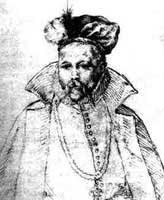Tycho Brahe 
(1546 - 1601 AD) Danish name: Tyge Brahe. Danish astronomer who set out to make accurate observations in order to be able to determine whether the Ptolemaic or Copernican system was the more correct. He was sponsored by King Frederick II of Denmark (not to be confused with the Holy Roman Emperor Frederick II, who lived from 1194-1250), who built him a castle on the island of Hveen (now Ven) between Denmark and Sweden called Uraniborg. This was the first real astronomical observatory, although alchemical researches were pursued in the basement. From Hveen, Brahe used a quadrant circle to sight the planets and stars. His large, accurate instruments yielded measurements which were accurate to within four minutes of arc. He compiled an extensive table of planetary positions and a star catalogue and made the most accurate naked eye astronomical measurements of his day. Brahe observed the Comet of 1577 and, by parallax measurements, determined that it was farther away than the moon and not an atmospheric phenomenon as Aristotle had claimed. This shattered Aristotle's notion of crystalline spheres, since the comet would have to travel through the spheres in its path through the heavens. He also observed the supernova of 1572, which inspired him to write De Nova Stella. Brahe developed his own "geoheliocentric theory" of planetary motions, in which the Sun orbited the Earth and the other planets orbited the Sun. Brahe hired Kepler as an assistant to analyze the vast bulk of data which had been collected. Although popular legend holds that Brahe died from uraemia and complications due to a ruptured bladder following too large a meal, recent research (Pallon 1996) points to mercury poisoning as the more probable cause. Following Brahe's death, Kepler obtained possession of Brahe's observations, and devoted himself to analyzing them. Brahe is reported to have written his own epitaph: "He lived like a sage and died like a fool" **The preceding information is provided by the Eric Weisstein's World of Scientific Biogra.** |